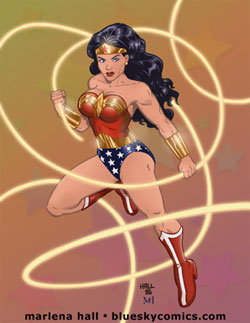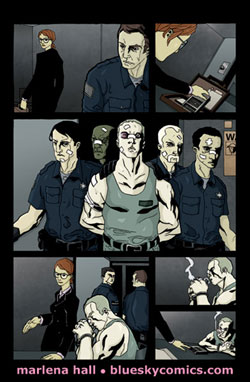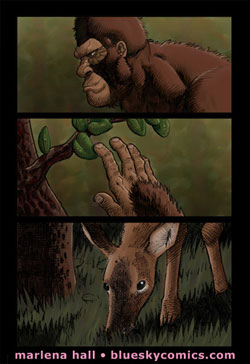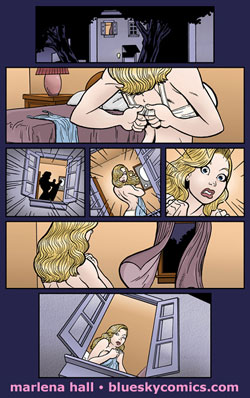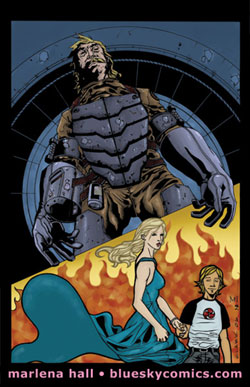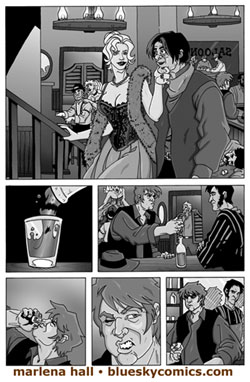Interviews
Interview With Colourist Marlena Hall
By Hervé St-Louis
May 13, 2007 - 23:58
About Marlena Hall
CBB: What series have you worked on before?
Marlena Hall: I got my start on a comic called Knights of the Dinner Table: Everknights that my husband worked on until the series ended. I've also worked on short stories for all three volumes of Dead@17: Rough Cut, the miniseries spinoff Dead@17: Protectorate, the upcoming anthology Josh Howard Presents: Sasquatch , Karma Incorporated and the back-up story for the miniseries Villains, all from Viper Comics. For Hoarse and Buggy I worked on a couple of short stories in their anthology series Western Tales of Terror. Currently I'm working on a web comic called Coral City Aeronauts with Villains artist, Ryan Cody and a comic called Knucklejelly with my husband, Ben.
CBB: What challenges did you find in them?
Marlena Hall: Lots! I've had no formal training so I am pretty much self taught with a LOT of help from Ben and the other artists that I work with. I had to give myself a crash course in lighting, shadows and color theory.
I started out coloring as a necessity for Ben to finish the Everknights comic and I got really used to working on his style of art, so when I started working with other artists it presented a challenge because the style that I used on Ben's art didn't always jive with the art of the other artists I've worked with, like Tom Kurzanski, Charlie Clark, and Mark Dos Santos.
CBB: What kind of training is required to be a comic book colourist?
Marlena Hall: Like I said before, I've had no formal training, so I don't think you really need it. But if you don't go to school for any of it, I think you have to have some sort of basic knowledge about color. Or at least have an eye for what works and what doesn't. I've bought a ton of books and I go through comics that I already have to study the color composition that I see in those books to give me ideas for my own work.
What you do need, however, is a knowledge of the programs that you work in to produce your work. You can have all the technique and natural ability in the world, but if you can't use Photoshop or any of the other programs out there, I don't think you'll be able to get very far.
CBB: What would you tell girls and boys who want to become colourists?
Marlena Hall: Practice, practice and more practice. Grab anything you can get your hands on and just color it. The more art you can work on, the better you will be.
I used to go online to places like Deviant Art and Digital Webbing to find black and white art and color it for my own satisfaction. Just to practice. A lot of times other artists will say they have a piece of art that they want colored and I would volunteer just for the experience.
Also, I'd say get your hands on as many comics, graphic novels, books and magazines that you can and study what you like. I have comics that I've bought just because I liked how the cover was colored, or the inside color scheme was neat. Then I can go back to those books and look for ideas for something I'm working on.
CBB: How many comic books/pages can you colour per week?
Marlena Hall: That really depends on the detail of the page. Some pages I can color in about 2 hours, others take me several days if the art is crazy with detail.
I'd say on average I can usually do about 5 pages per week, barring any computer or time issues.
About Comic Book Colouring
CBB: Comic book colouring, although it has come from the dark ages, is still the one of the production steps in comic book production that are often overlooked. How do you feel about this?
Marlena Hall: I think it truly is a waste and it saddens me.
We're still in a time where a black and white comic book is a lot easier and cheaper to produce, so only the major publishers and some small ones can get away with producing books in color. But, that being said, even black and white books can have great detail added to them with gray tone shading applied to the art.
That's one of the reasons I like working with Viper Comics is because almost all of their titles are produced in color, and that is a big deal for a smaller independent publisher.
Producing a comic in color is still considered an "add-on", I think. Like getting power windows in a car. You don't necessarily need them, but most people want them. Hopefully colorists will get more of the recognition they deserve as time goes on.
CBB: Before Adobe Photoshop, colourists did not have the means to correct artwork. Do you find that more and more, colourists patch up artists' work?
Marlena Hall: Maybe other colorists do, but so far, I've been lucky enough that I've rarely had to do that. The most I ever have to do is fix the levels of the artwork if I get a bad scan of it. Sometimes the blacks aren't true blacks or there are imperfections in the whites. If that's the case then I will go in and make minor cosmetic changes, but the artists I've worked with have always been really good about giving me the best art to work from.
Moreso, in my experience, I've have just gotten to add more to a page, usually backgrounds, that the artist don't draw for me. Which gives me creative freedom, but can also be challenging at the same time.
CBB: Is the line between comic book inking and colouring blurring?
Marlena Hall: I don't think so, at least I hope not. Inking and coloring are very different skills in my opinion. I wouldn't trust myself to ink a comic page if my life depended on it.
If someone can do both, more power to them.
CBB: What is the most satisfying part of your work?
Marlena Hall: I think it's seeing the finished product in print is just rad. I like walking into a comic store and seeing something I've worked on sitting on the shelf. Then I think about someone picking it up and hopefully liking what they see.
I love the feeling of accomplishment I get after the completion of a project.
Because It's Women's Month!
CBB: Have you found it more difficult to find your place in this industry because you were a woman?
Marlena Hall: A little bit, but not as much as you'd generally think. I do a lot of work for Viper, and I think I'm still the only woman involved in any of their projects (If I'm wrong, please let me know!) so I think it's kind of cool, but at the same time I wish I wasn't the only one.
But I've never had anyone say no to me because I'm a woman. I'm pretty nerdy and I don't consider myself a "typical" girl so I think my personality has helped me along in this field.
I think with organizations like Friends of Lulu and more high profile and accessible comics for girls and women out there now, the industry is becoming, albeit slowly, a place for women to feel very comfortable. I would love to see it as less of a "boy's club", because girls like comics too and not just the fluff stuff.
CBB: Do you think that the design approach, when handling a comic book is the same for a woman and man?
Marlena Hall: I think for the most part yes, but men and women are different and we do see things differently. I've been told on many occasions (by my male artists) that my color choices are not always what they had in mind, but that they have been pleasantly surprised and like what I've done more than what they would have done if they'd colored it themselves.
So, while men and women may have their own styles, I think it's true for all artists that no one will approach the same project in the same way.
CBB: Do you find that there are they proportionally more women colouring comic books, than doing other production steps like writing or inking?
Marlena Hall: Honestly, I don't really know. There may be more women working on comics that are more well-known, but I'm sure there are plenty of women out there doing it all and doing it well.
CBB: Do you know anything about Janet Jackson, the semi mythical colourist who worked on so many series, I lose track off?
Marlena Hall: Umm, no. Is this a trick question or have I just shown how green I am?
About The Craft
CBB: What artists inspire you the most?
Marlena Hall: Other than my greatest inspiration (and my biggest supporter), Ben, I'd have to say Kyle Baker and Terry Moore.
I know Terry Moore's comic Strangers in Paradise is in black and white, but the fact that he's been able to take a small independent story and turn it into a lucrative career is just awe inspiring. I'd love to have a success story like that.
Kyle Baker has been one of my favorite artists for as long as I can remember. I love his style and his colors on his books are just mindblowing. His use of color that you normally wouldn't think of to use just works in his art, and I love that.
CBB: What is your design approach?
Marlena Hall: Usually I get the art from the artist in digital format and I will bring it into Photoshop and look for any imperfections in the art, like smudges, line breaks or things like that. I then check the levels of the blacks and whites and make adjustments if I need to.
After that I will lay down "flats". Which are flat colors that just separate the individuals components of the art on the page. I try to use flats that will be the final colors for the page where I can, but sometimes I just use crazy colors so I can tell the elements of the page apart.
I choose my color palette based on notes from the artist, the script, what time of day it is in the story, the location of the characters, the mood of the story, things like that.
After that I'll finish the page using both Photoshop and Painter, depending on how I want the page to look.
CBB: Some artists think in lines and some in tones? How does that playout for you once you receive the artwork?
Marlena Hall: I always think in tones. In everything I look at, I think about the colors, how they go together and if they work or not.
I'll be the first to admit that my weakest technique is lighting and shadows. So I'm always looking at the way light hits things and the shadows it produces because I'm always trying to improve this aspect of what I do.
CBB: Something I've always meant to ask. Did you have to purchase an 18 x 12 scanner or are the black and white pages pre-scanned by the publisher?
Marlena Hall: I actually already owned a scanner, but it's not that big. Usually we'll scan it in two parts and piece it back together in Photoshop.
If I'm working on art from Ben, he will scan it in and clean it up for me. And all of the other artists I work with do the same; they will scan it in and send it to me digitally or if the file is too big, via FTP. Most publishers work digitally now, I think. When we're ready to submit the finished artwork to the publisher, they usually have us upload it to their FTP.
Your Current Work
CBB: Where can we see more of you work these days?
Marlena Hall: Ben and I just completed a story for the Viper Comics anthology Josh Howard Presents: Sasquatch, which I believe will be in stores by the end of this month if it isn't on the shelves already.
I'm also working on the web comic Coral City Aeronauts with Ryan Cody which has new pages uploaded every Monday.
http://coralcity.blogspot.com/
Ben and I also have a backup story, written by Ken Lowry, in the upcoming Black Diamond comic, being published by AIT/PlantLar, which I'm finishing the colors on right now.
There's also Knucklejelly, another project Ben and I are working on, which will hopefully be out sometime this year or early next year.
CBB: Do you have a gallery The Comic Book Bin's readers can check out?
Marlena Hall: Yup! Go to my website: www.blueskycomics.com. It's chock full of fun stuff for readers to look at.
A more direct link is:
www.blueskycomics.com/marlena/portfolio.asp
CBB: Thank you very much for answering these questions.
Last Updated: March 3, 2025 - 20:40
